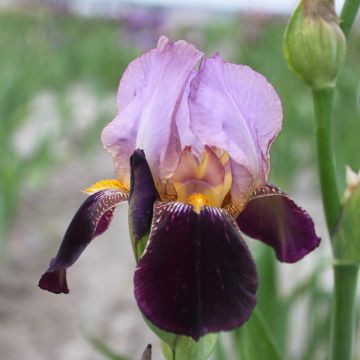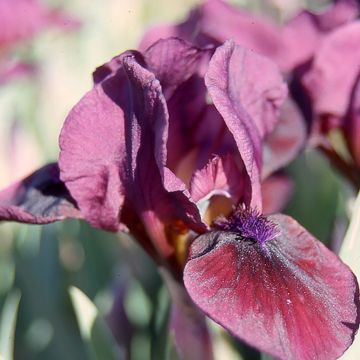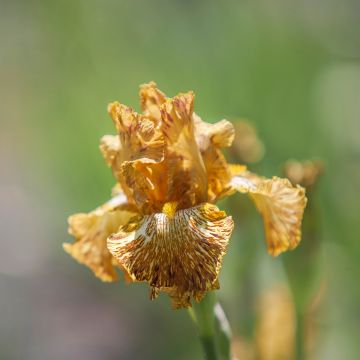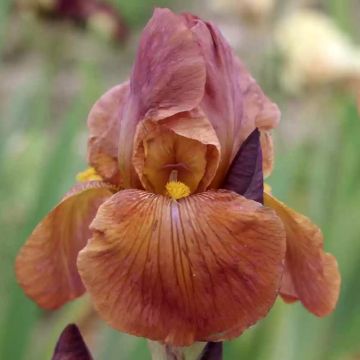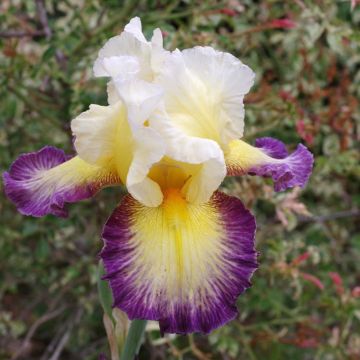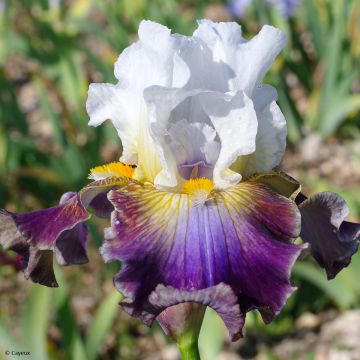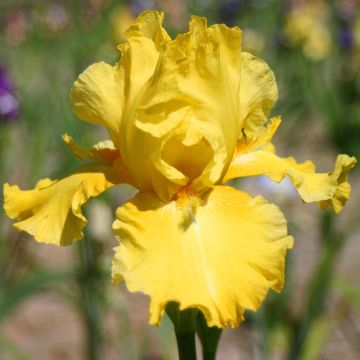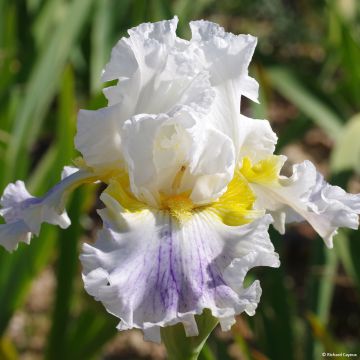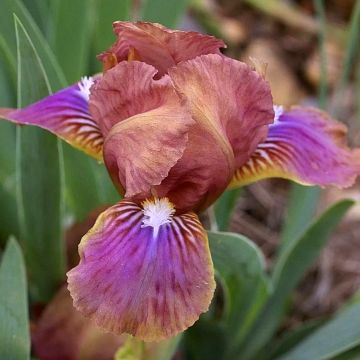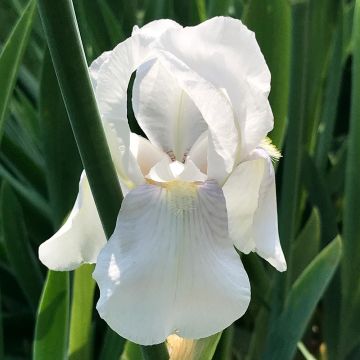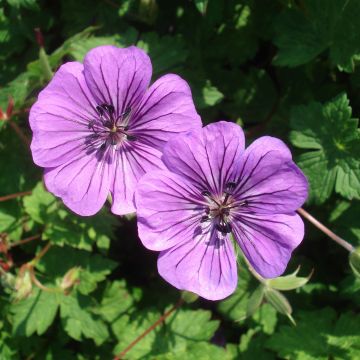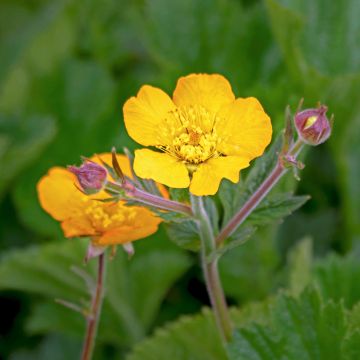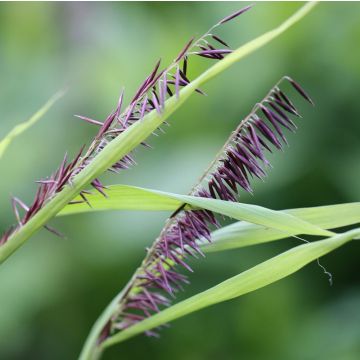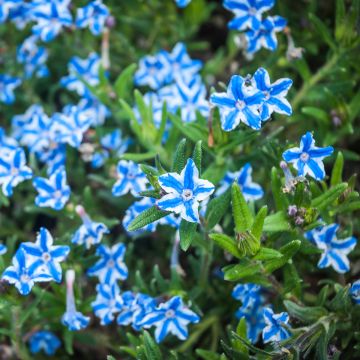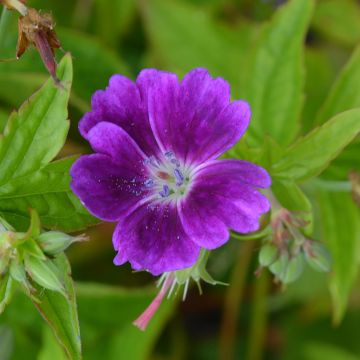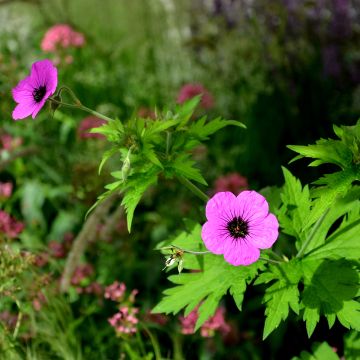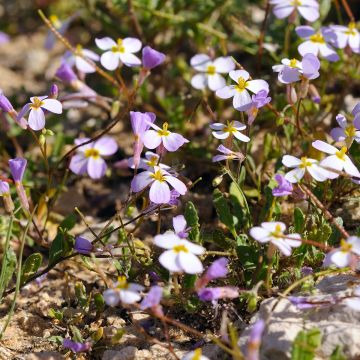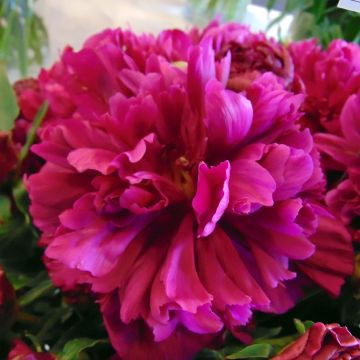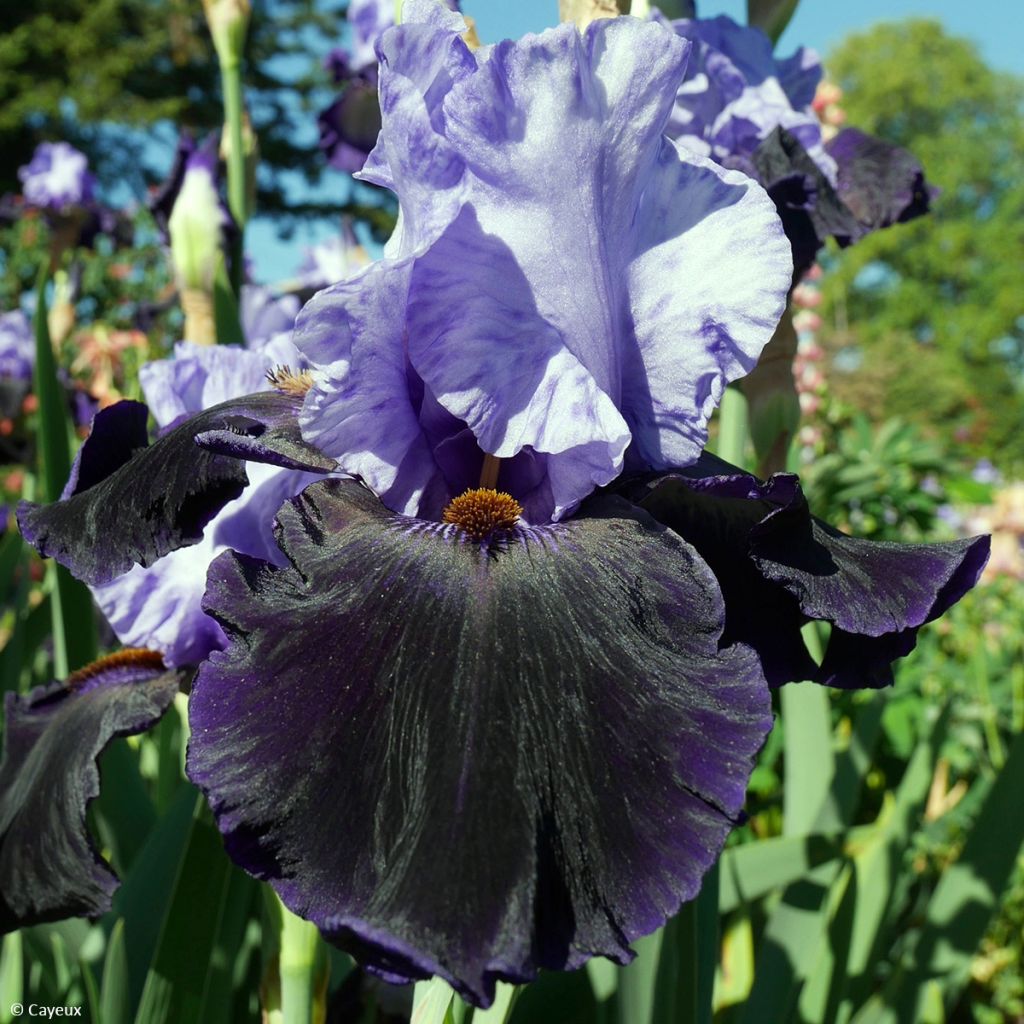

Iris germanica Dangerous Mood
Iris germanica Dangerous Mood
Iris germanica Dangerous Mood
German Iris, Bearded Iris
This item cannot be shipped to the selected country
Delivery charge from €5.90
Delivery charge from €5.90
More information
Schedule delivery date,
and select date in basket
This plant carries a 12 months recovery warranty
More information
We guarantee the quality of our plants for a full growing cycle, and will replace at our expense any plant that fails to recover under normal climatic and planting conditions.
From €5.90 for pickup delivery and €6.90 for home delivery
Express home delivery from €8.90.
From €5.90 for pickup delivery and €6.90 for home delivery
Express home delivery from €8.90.
Does this plant fit my garden?
Set up your Plantfit profile →
Description
The 'Dangerous Mood' German Iris is distinguished by rapid propagation and the production of robust stems. The sepals are adorned with a deep velvet blue and tousled texture, while the three upright petals, called standards, are of pure white tinged with indigo blue. The beards of this iris are blackish purple with yellow tips. This variety develops rapidly, forming beautiful clumps that bloom in spring, bringing brightness to flower beds, rock gardens, or borders for several weeks.
Iris germanica is a perennial rhizomatous and deciduous plant that forms erect, vigorous clumps. It belongs to the Iris family, which also includes plants such as Crocus, Gladiolus, and Crocosmia. The Iris germanica, or German Iris, is a species likely resulting from the hybridization of different botanical species. As a member of the Bearded Iris group, recognisable by the fine crest on the sepals, it is one of the most cultivated irises in gardens. These plants prefer neutral to alkaline soils and require sunny exposure to thrive. The rhizomes need to capture the heat of the sun during the summer to ensure optimal flowering. Traditionally, a minimum of six hours of sun per day is required for their development.
The variety 'Dangerous Mood' was obtained by Ray Schreiner in 2004 in the United States. Awarded in 2006 by the American Iris Society (AIS), this excellent variety produces stems that reach a height of 80 to 90 cm (32 to 35in) when in bloom. It has strong floral stems that develop from the rhizomes, with well-built spikes carrying numerous flower buds. The clumps spread rapidly and indefiitely, as the central rhizomes become bare in favour of the outer ones. The leaves are long and sword-shaped, with a pronounced glaucous green colour and strong veins. In April the flower stems begin to appear, and in May, depending on the climate, they produce wide flowers measuring 13 to 15 cm (5 to 6in) that open from the top down to the lower branches, until the end of June. The dark colouring of this plant is enhanced by the silky and iridescent texture of the petals and sepals, as is generally the case with bearded Irises.
Irises easily combine with other plants, whether perennials, grasses, or shrubs. In order to accompany irises well it is important to select plants based on their specific requirements, such as sun exposure and soil type, and to ensure that their growth does not suffocate the iris rhizomes by opting for low-growing plants with light foliage. Also consider their complementarity in terms of visual appearance and flowering period. Furthermore, it is essential to remember that clumps need to be divided every 3 or 4 years, which means reserving them adequate space, without competition, preferably in well-drained and not too compact soil. To create attractive floral beds throughout the growing season, it is recommended to associate irises with long-flowering perennials that tolerate dry soils, such as gauras, sages, or perennial geraniums. Columbines and California Poppies (Eschscholzia) bring lightness, while clematis create an attractive background. For more verticality, foxgloves are suitable. And don't forget foliage, such as grasses, silver wormwoods (Artemisia), or euphorbias.
Dense planting of old vigorous iris varieties allows for the stabilization of a slope, thus limiting maintenance. At the foot of a very sunny wall, sheltered from the wind, tall irises can be planted in the background, while shorter and early varieties can be used in the foreground. A few clumps of irises can also bring cheerfulness to the vegetable garden, and their beautiful flower stems can be used to make bouquets.
Report an error about the product description
Flowering
Foliage
Plant habit
Botanical data
Iris
germanica
Dangerous Mood
Iridaceae
German Iris, Bearded Iris
Cultivar or hybrid
Other German Iris - Bearded Iris
Planting and care
Does your garden have a sunny area, sheltered from the wind, that is warm and rather dry in summer? This is the ideal location for planting irises! In the shade they will grow but do not flower. They are hardy and do not need winter protection. Well-drained soil is perfect, even if it is rather dry. Iris germanica require alkaline soil: amend yours with lime if it tends to be acidic. Excessively wet soil promotes rhizome rot. Plant from July to September: this allows the rhizomes to grow sufficiently before lifting, and to develop new roots before winter. For best results they should be planted as soon as they are purchased. Plan to divide the iris every 4 years or so to give them fresh soil. They have strong growth and need space to develop and flower well. They are planted with spacing appropriate to the size and vigour of the variety: about 34-50 cm (13-20in) for tall ones (5 to 10 plants per square metre). In a monochrome planting, the rhizomes are planted in a staggered pattern. When mixing colours, it is recommended for the overall aesthetics of the iris bed to plant them in groups of several plants of the same variety. Always consider the direction of rhizome growth by arranging them in a star shape, with buds and leaves facing outward, and spacing them well in relation to other varieties so they have room to develop.
Planting:
Dig a hole that is wide and deep enough for the roots. Make a large conical mound of soil in the hole, on which the rhizome and spread-out roots are placed. Cover the roots. It is important that the rhizome is left just above the surface of the soil. It should not be planted in a depression (risk of rot), so anticipate that the soil will settle and the iris will sink. In clayey or damp soil, the rhizome should even be left raised on a slight mound of a few centimeters. To make the soil adhere to the roots, lightly compact the soil and water it abundantly after planting. Water 2-3 times if necessary until the plant establishes.
Maintenance:
Keep the soil free of weeds by shallow hoeing, taking care not to damage the rhizomes or roots. Weeds create shade for the irises, retain moisture (causing rot), and attract slugs. Similarly, remove dry leaves. If they are diseased (reddish-brown bordered spots of heterosporiosis), burn them. Remove faded flowers to prevent the plant from wasting energy on fruit formation.
Planting period
Intended location
Care
This item has not been reviewed yet - be the first to leave a review about it.
Spring flowering perennials
Haven't found what you were looking for?
Hardiness is the lowest winter temperature a plant can endure without suffering serious damage or even dying. However, hardiness is affected by location (a sheltered area, such as a patio), protection (winter cover) and soil type (hardiness is improved by well-drained soil).

Photo Sharing Terms & Conditions
In order to encourage gardeners to interact and share their experiences, Promesse de fleurs offers various media enabling content to be uploaded onto its Site - in particular via the ‘Photo sharing’ module.
The User agrees to refrain from:
- Posting any content that is illegal, prejudicial, insulting, racist, inciteful to hatred, revisionist, contrary to public decency, that infringes on privacy or on the privacy rights of third parties, in particular the publicity rights of persons and goods, intellectual property rights, or the right to privacy.
- Submitting content on behalf of a third party;
- Impersonate the identity of a third party and/or publish any personal information about a third party;
In general, the User undertakes to refrain from any unethical behaviour.
All Content (in particular text, comments, files, images, photos, videos, creative works, etc.), which may be subject to property or intellectual property rights, image or other private rights, shall remain the property of the User, subject to the limited rights granted by the terms of the licence granted by Promesse de fleurs as stated below. Users are at liberty to publish or not to publish such Content on the Site, notably via the ‘Photo Sharing’ facility, and accept that this Content shall be made public and freely accessible, notably on the Internet.
Users further acknowledge, undertake to have ,and guarantee that they hold all necessary rights and permissions to publish such material on the Site, in particular with regard to the legislation in force pertaining to any privacy, property, intellectual property, image, or contractual rights, or rights of any other nature. By publishing such Content on the Site, Users acknowledge accepting full liability as publishers of the Content within the meaning of the law, and grant Promesse de fleurs, free of charge, an inclusive, worldwide licence for the said Content for the entire duration of its publication, including all reproduction, representation, up/downloading, displaying, performing, transmission, and storage rights.
Users also grant permission for their name to be linked to the Content and accept that this link may not always be made available.
By engaging in posting material, Users consent to their Content becoming automatically accessible on the Internet, in particular on other sites and/or blogs and/or web pages of the Promesse de fleurs site, including in particular social pages and the Promesse de fleurs catalogue.
Users may secure the removal of entrusted content free of charge by issuing a simple request via our contact form.
The flowering period indicated on our website applies to countries and regions located in USDA zone 8 (France, the United Kingdom, Ireland, the Netherlands, etc.)
It will vary according to where you live:
- In zones 9 to 10 (Italy, Spain, Greece, etc.), flowering will occur about 2 to 4 weeks earlier.
- In zones 6 to 7 (Germany, Poland, Slovenia, and lower mountainous regions), flowering will be delayed by 2 to 3 weeks.
- In zone 5 (Central Europe, Scandinavia), blooming will be delayed by 3 to 5 weeks.
In temperate climates, pruning of spring-flowering shrubs (forsythia, spireas, etc.) should be done just after flowering.
Pruning of summer-flowering shrubs (Indian Lilac, Perovskia, etc.) can be done in winter or spring.
In cold regions as well as with frost-sensitive plants, avoid pruning too early when severe frosts may still occur.
The planting period indicated on our website applies to countries and regions located in USDA zone 8 (France, United Kingdom, Ireland, Netherlands).
It will vary according to where you live:
- In Mediterranean zones (Marseille, Madrid, Milan, etc.), autumn and winter are the best planting periods.
- In continental zones (Strasbourg, Munich, Vienna, etc.), delay planting by 2 to 3 weeks in spring and bring it forward by 2 to 4 weeks in autumn.
- In mountainous regions (the Alps, Pyrenees, Carpathians, etc.), it is best to plant in late spring (May-June) or late summer (August-September).
The harvesting period indicated on our website applies to countries and regions in USDA zone 8 (France, England, Ireland, the Netherlands).
In colder areas (Scandinavia, Poland, Austria...) fruit and vegetable harvests are likely to be delayed by 3-4 weeks.
In warmer areas (Italy, Spain, Greece, etc.), harvesting will probably take place earlier, depending on weather conditions.
The sowing periods indicated on our website apply to countries and regions within USDA Zone 8 (France, UK, Ireland, Netherlands).
In colder areas (Scandinavia, Poland, Austria...), delay any outdoor sowing by 3-4 weeks, or sow under glass.
In warmer climes (Italy, Spain, Greece, etc.), bring outdoor sowing forward by a few weeks.

































